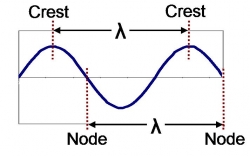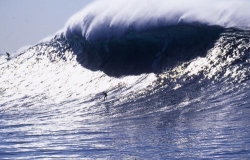Grab your space bicycle. Today, we're riding a light wave. If you look at a ray of light, you will notice that it moves up and down and up again, like hills. Why does light move this way? We have not figured that out yet! Maybe it wiggles to move faster like a snake. Maybe it just likes to dance. Either way, let's get going. I see a light wave coming across from the setting sun. Let's take a look, but make sure to put on your sunblock.Since light waves are shaped like hills, it's easy to think about riding a bicycle up and down a light wave. The best part about riding light waves is we get to start downhill! The first part of the wave drops down in a steep curve. Feel the rush as you drop down into a great dip, like a roller coaster falling down the track! When we stop falling, we're on the flat part of the wave. The lowest part of a light wave is called a trough. If you need a way to remember this term, think of pigs eating out of troughs. They need their food low in order to get to it. From the bottom you can see the top of the wave in front of and behind you, but nothing else. We need a better view for that. So pedal! Pedal fast!

Crest to crest, I can do this all day long.
With all of that speed, you fly up the next hill. You can only make it about half of the way before you have to pedal hard again. Finally, you reach the top. You can rest for a second. This highest point on the wave is called the crest. From here, you will be able to see the dips in front of and behind you as well as the crests of those hills. What's a good way to remember crest? Well, Crest is a kind of toothpaste, and you should put brushing your teeth at the top of your list.

Look out below! High amplitude wave coming through.
Roy Miller, Mount Holly DAPM.(Surf's Up!), Public domain, via Wikimedia Commons
Ready? Push off again. As you race down the light wave, you notice that you are falling much farther than the first wave. You drop twice as far as the height or depth of the last hill. How can you tell your friends just how crazy that drop was? We can measure the size of a wave by you starting at the middle and either going up to the top or down to the bottom. Amplitude is the distance from the middle of the wave to either the top or bottom. The more you have to pedal with your bike or the more you feel your stomach drop when you ride down, the bigger the amplitude. How will we remember amplitude? Well, sound moves the same way as light: in waves! You may have seen a guitar amp. When it's really loud, it makes a lot of strong waves!With all of this rising and falling, you have ridden far away from where you started. How far have you come? How far do you need to ride to get back home? In order to measure waves, you look at the distance between a point on one wave to that exact same point on the next wave. Let's say from crest to crest. The length between the same point on two waves is called the wavelength. This is an easy one to remember. Just put wave and length together.These new words you learned can be used to describe any wave: sound waves, light waves, ocean waves, waves on a graph, or even the waves you and a friend make while holding a jump rope and moving your arms up and down. Could we ride one of these light waves to the sun, you ask? Ha. No! The sun is another 93 million miles away. Although I'm sure with some light riding practice, you could make it to the horizon. Just keep pedaling.Resources:
"What Is Light?" How Stuff Works. Discovery, 2010. <http://science.howstuffworks.com/light1.htm>
"The Anatomy of a Wave." Physics Classroom, 2002. <http://www.physicsclassroom.com/class/waves/u10l2a.cfm>
"Characteristics of Sound and Light Waves." Concordia College, 1999. <http://wwwp.cord.edu/faculty/manning/physics215/studentpages/angieevanson.html>
"Double slit experiment." The Science Classroom, 2011. <https://thescienceclassroom.wikispaces.com/Double+slit+experiment>
"How Radio Works." How Stuff Works. Discovery, 2010. <http://electronics.howstuffworks.com/radio7.htm>
"How Light Works." How Stuff Works. Discovery, 2010. <http://science.howstuffworks.com/light7.htm>